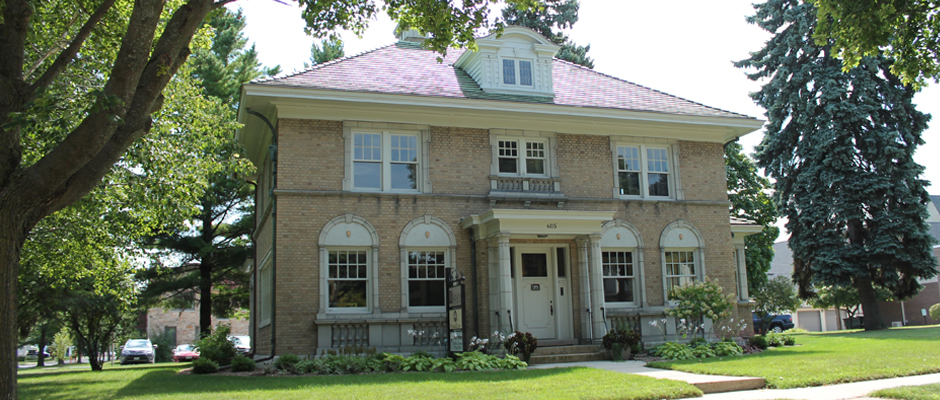A Sense of Place: Restoring Home in a Sustainable Way
Schultz, Deanne. The Sheboygan Press, February 3, 2015, page A1.
When Eliza Prange built her gracious Mediterranean-style house at 605 Erie Ave. in 1923, skilled craftsmen used enduring building materials like brick, six-inch stud walls, and leaded-glass windows. It was testament to Eliza's hope of living there for years to come.
She died unexpectedly in 1928, when she was 66 years old, but her house still echoes with the "embodied energy" created in its construction.
Legacy Architecture's Jennifer Lehrke, 605's current owner, said the term refers to the time and effort spent by the craftsmen who labored there, and also includes "the energy used to produce a material, put it in place, and let it serve its useful life."
Ultimate form of recycling
Because the home has stood for almost a century, it exudes a sense of place that called to Lehrke when she bought it last year. Lehrke's goal of renovating the house speaks to her philosophy of sustainability, specifically that "historical preservation is the ultimate form of recycling."
In 2007, Lehrke attended the Historic Districts Council Annual Conference in New York, where she heard a lecture by Donovan Rypkema, principal of PlaceEconomics, a Washington, D.C.-based real estate and economic development consulting firm. His speech crystallized her belief in the necessity of historic preservation as the ultimate means of sustainability.
Rypkema said when historic buildings are razed in favor of new construction, we not only throw away all the embodied energy used in constructing the building, but we also replace it with materials he called "much more energy consumptive," like plastic, steel, vinyl and aluminum.
Historic preservation also "waters the roots" of the surrounding community, he said. Because these buildings are often centrally located, they take advantage of existing infrastructure and provide tenants with easy access to shopping, transportation and amenities.
The Prange house at 605 Erie meets these conditions, Lehrke said.
Maintaining integrity
To maintain the home's historic integrity, Lehrke chose permeable pavers for her winding sidewalk. Toby Roth, co-owner of Edgewood Landscape in Howards Grove, installed the fired-clay permeable pavers, which meet American Disability Act standards and provide for natural melting of snow and ice.
Lehrke obtained a variance from the City of Sheboygan that allowed her to reduce the number and configuration of the parking spaces.
"If we followed the city's zoning ordinance to a 't' we would have had to remove all the trees and pave the entire backyard," she said. "We didn't need that many parking spaces."
Along with preserving the trees, Lehrke hired a landscape designer to plant hostas, hydrangeas and boxwoods, reminiscent of those growing in Eliza Prange's time.
"Humans function better with green space around them," said Joe Azzarello, senior staff sustainability engineer at Kohler Co. and founding member of the U.S. Green Building Council.
Making a big difference
"It provides a wonderful place to rest and meet, and the less space you have covered by concrete or asphalt, the more it helps with storm water flow," he said.
Azzarello said sustainability speaks to the fact that people realize there are a finite number of natural resources available, and their decisions can make a big difference.
"We would all like a good standard of living," he said. "And we can continue to live with a good quality of life by making easy and smart decisions."
Lehrke incorporated that theory inside 605, where she used sustainable details to enhance the physical and psychological comfort of the people within.
No- and low-VOC (volatile organic compounds) paints were used, which release no or low levels of toxic emissions. An air-conditioning and ventilation system was installed with separate zones for each floor, along with carbon monoxide detectors to monitor indoor air quality.
Sustaining well-being
"Everyone's desk also has a task light," she said. "That helps well-being, and gives people control of their visual comfort."
Although the storm windows were replaced - and their aluminum and glass components recycled - Eliza's original window configuration remains the same. The generous windows admit plenty of sunshine, reducing the need for indoor lighting.
And as the owner of a historic building, Lehrke is attached to it in a special way. "This is another life, another era for this house," she said.
Make your house more sustainable
Joe Azzarello, with Kohler Co., suggests the following easy ways for homeowners to incorporate sustainable features into their homes:
Switch out incandescent bulbs for LED bulbs, which can last for a decade and provide a great payback.
Purchase low-flow faucets and low-flush toilets. Install water-reducing aerators for faucets.
When having a new roof installed, recycle the old shingles.
Install proper amounts of insulation, one of the least-costly items with the highest payback for homeowners.
Plant indigenous species of plants in your yard. They tend to require the least amounts of water and will thrive in their native surroundings.
Visit www.greenhomeguide.com to learn more.

